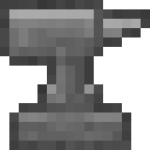Anvil
| Anvil | |
|---|---|
| Type: | Craftable Item |
| Found naturally: | No |
| Renewable: | No |
Anvils are blocks that use the item repair interface to repair and to rename items, as well as to combine enchantments.
Usage
Anvils can be used to repair tools and armor, to enchant items with enchanted books, and to rename items and blocks. All of their functions cost experience levels (earned by performing certain actions) and crafting materials.
Anvils have a 12% chance to degrade for each use and will eventually be destroyed by such use. On average, an anvil will survive for 24 uses, which is approximately one use per 1.3 iron ingots used in crafting the anvil.
Anvils are affected by gravity in the same way as sand and gravel are. A placed anvil cannot be pushed or pulled by pistons, but a falling anvil can. Falling anvils can do considerable amounts of damage to mobs or players, so they can be used in traps. However, anvils themselves have a chance to be damaged by the fall as well. Damaged anvils can still be used.
Crafting
|
| ||||||||||||||||||||||||||||||||||||||||||||||||||||||||||
Repairing and Renaming
Anvils have two modes to repair items that have a durability rating:
- As with the crafting grid, a player may repair items by combining two similar items. With the anvil, however, the target will keep its enchantments, and may gain new ones from the sacrificed item.
- Alternatively, a player can use materials originally required in the crafting of the item (iron ingots for iron items with durability, diamonds for diamond items with durability) to repair a single item. One material can only repair 25% of the target's maximum durability.
In addition, the player can rename any item - not just items with durability - by using an anvil.
Repairing
Repairing with materials works for the most part, but not with all items: As a rule of thumb, it works for items with their material in the default name, like iron pickaxe, so it can be done with various tools except for bows and shears. The repair does not need to be complete; one material will only repair 1⁄4 of the item's maximum durability.
Repairing with a matching item works for any item with durability including bows, shears and so on. The items must match in type; you cannot combine a golden pickaxe with an iron one, for example.
Note that in both cases the resulting durability will be limited to the item's maximum, and there is no discount for "over-repair".
As a subset of repairing one item with another, the anvil can transfer enchantments from the sacrifice to the target. This can have a synergistic effect when both items share identical enchantments, or simply add to each other when they do not. Two Sharpness II swords can be combined to make a Sharpness III sword, for example, or a pickaxe with Efficiency can be combined with one that has Unbreaking. This can produce enchantments and combinations that could not be made by using an enchanting table. But even so, some enchantments cannot be combined if they are similar, or contradicting, in context of what it does. If the target is damaged, you will pay for the repair as well as the transfer.
Transferring high-level enchantments is more expensive, and renaming an item has an additional surcharge.
Renaming
Any item or stack of items can be renamed at a cost of one level plus any prior-work penalty. If the player is only renaming.
- A name tag must be renamed before it can be used
- A renamed spawn egg will produce a mob with the same name
- Chests, furnaces, droppers, dispensers, enchantment tables, and brewing stands will display the name in their GUI when placed.
- Upon breaking the block or minecart, its name is lost.
- Any other block will lose its name upon placing it.




